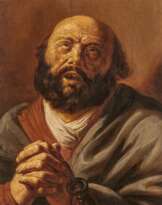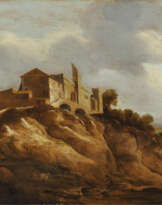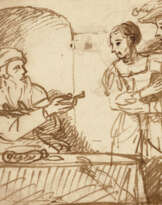ID 1424101
Lot 1219 | Susanna and the Elders
Estimate value
€ 40 000 – 60 000
1607 Leiden - 1674 Amsterdam
Title: Susanna and the Elders.
Date: Ca. 1630/31.
Technique: Oil on wood.
Measurement: 50 x 42cm.
Frame: Framed.
Verso:
On the plate old collection seal Buchenau as well as labels Kunsthandel Agnew & Sons, London.
Certificate:
Dendrochronological investigation by Prof. Klein, University of Hamburg 27.03.2023: The earliest date on which the tree was felled is given as 1627, which, together with the time the wood was stored, gives a date of origin for the painting of 1629.
Exhibition:
"Rembrandts Social Network", Museum Het Rembrandthuis, Amsterdam 01.02.-19.05.2019.
Provenance:
Private ownership, Germany, since 2023;
Private ownership, Germany, since 1994;
Auction Dorotheum, Vienna 01.03.1994, lot 124;
Kunsthandel Agnews London;
Auction Christie's, New York, Sale Mrs H.A Brooks et al. 02.06.1998, lot 86;
Kunsthandel Agnews London, 1980, cat.no. 2;
Private collection Switzerland, since 1969;
Wildenstock Gallery, New York, 1959;
Buchenau Collection, Niendorf/Lübeck;
Galerie Haberstock, Berlin;
Hermine Reuss zu Greiz Collection (1887-1947), second wife Wilhelm II.
Literature:
B. Schnackenburg: Jan Lievens: Freund und Rivale des jungen Rembrandt: mit einem kritischen Katalog des Leidener Frühwerks 1623-1632, Petersberg 2016, no. 154, p. 335ff with ill.;
D. de Witt: Rembrandt and the Climate of religious Conflict in the 1620s. In: Jahrbuch der Berliner Museen, NF 51, 2009, enclosed booklet, p. 19ff, ill. 3;
W. Sumowski: Gemälde der Rembrandtschüler, Landau 1983, vol. III, cat. no. 1192, p. 1781, ill. p. 1831. (here listed as work by Jan Lievens and with old cited literature in which the painting is listed as Rembrandt's work);
R. Klessmann: Katalogtexte zur Ausstellung "Lievens, ein Maler im Schatten Rembrandts", Ausst. Braunschweig 1979, p. 228, comm. 1 (as work by Jan Lievens ca. 1630/31).
The painting is registered under ill. no. 309004 at the online data base of the RKD, The Hague.
The climax of Susanna's story is depicted as if on a stage, illuminated by bright spotlights: The beautiful young woman, Susanna, is sexually assaulted by two old men - who also happen to be two judges - while being groomed. Susanna is able to fend them off and screams loudly for help. She will be able to preserve her virtue as the story progresses. The wise young prophet Daniel will convict the two lechers, who will use all their power to slander the victim. But here the screaming Susanna is still defending herself to the best of her ability, grabbing the beard of one of the attackers with her right hand, while her left hand tries to push the other man's arm away. All three people are clearly looking towards the right edge of the picture. Is the help that Susanna's scream has summoned already approaching?
The setting in which the action takes place is not easy to grasp; so dark is the space surrounding Susanna's light-coloured nudity and her white scarf, which the man on the left has seized. A stream of water gushes in the left foreground; glittering jewellery and a metal jug lie on the floor. The background is closed off at the left edge of the picture by a round arch through which a landscape at dusk can be seen. At the right-hand edge of the picture, the grotto-like space appears to be bordered by a tree. A bouquet of flowers stands out in this unusual place, illuminated by the grazing light.
For a long time, this panel was considered an authentic work by Rembrandt and was in imperial possession. However, art historical research (including R. Klessmann and Werner Sumowski) finally recognised this painting as the work of the Leiden painter Jan Lievens and dated it to the early 1630s. An existing dendrochronological expertise can support this date.
Jan Lievens is known as an exceptionally precocious artist. He learnt the profession of a painter from the age of nine: first in his home town, then from 1618 to 1620 with Pieter Lastman in Amsterdam. Back in Leiden, Jan Lievens formed a studio partnership with the only slightly younger Rembrandt Harmensz. van Rijn from 1625. The latter was also from Leiden and had also studied with Pieter Lastman - albeit somewhat later than Lievens and for only six months. The two young artists worked together for around five years and influenced each other's work. Both specialised in portraits and history paintings and occasionally worked closely together. To this day, art historians often struggle to clearly categorise the works created during this phase.
The contrast between light and dark in the present work, as well as the way in which the female body is depicted, are very similarly familiar from certain Rembrandt paintings. According to the assumed dating, the painting was probably created immediately after the period in which Jan Lievens and Rembrandt shared a studio in Leiden and influenced each other stylistically.
After the end of the studio partnership, around 1632, Jan Lievens initially went to England for three years. There he came into contact with the royal court and was probably also influenced by Anthonis van Dijck. He returned to Antwerp in 1635 and was granted citizenship there in 1640. His career also took him to Amsterdam, The Hague, Berlin (Oranienburg Palace) and finally back to Amsterdam in 1655. Jan Lievens was a very successful artist who received important public and private commissions. However, the painter does not appear to have any commercial talent and his occasional need to flee from creditors may also be a reason for his many relocations. Jan Lievens died impoverished in Amsterdam in 1674.
In 2022, the 'Wallraf-Richartz-Museum' in Cologne reappraised the biblical story of Susanna as a pictorial theme in a major exhibition and examined it with a contemporary, critical eye. The panel on display here shows an almost 400-year-old depiction of the roles of power and powerlessness of the sexes that is currently so topical. This work from Lieven's best creative period, which has now reappeared in a private collection after 30 years, is one of the far rarer figurative paintings, alongside the many high-quality portraits, which hardly ever appear on the market as they are in permanent collections or museum collections.
| Artist: | Jan Lievens I (1607 - 1674) |
|---|---|
| Applied technique: | Oil |
| Auction house category: | Old Master Paintings |
| Artist: | Jan Lievens I (1607 - 1674) |
|---|---|
| Applied technique: | Oil |
| Auction house category: | Old Master Paintings |
| Address of auction |
VAN HAM Kunstauktionen GmbH Hitzelerstr. 2 50968 Köln Germany | ||||||||||||||
|---|---|---|---|---|---|---|---|---|---|---|---|---|---|---|---|
| Preview | |||||||||||||||
| Phone | +49 221 92586215 | ||||||||||||||
| Fax | +49 221 92 58 62 4 | ||||||||||||||
| Buyer Premium | 32% | ||||||||||||||
| Conditions of purchase | Conditions of purchase | ||||||||||||||
| Business hours | Business hours
|














